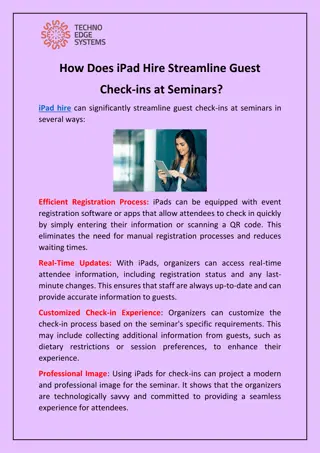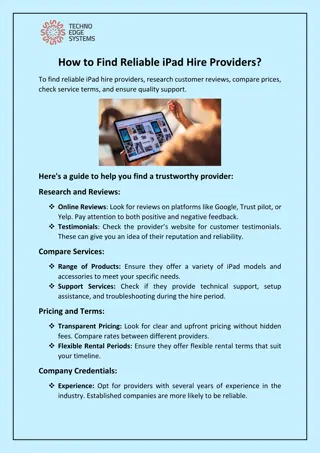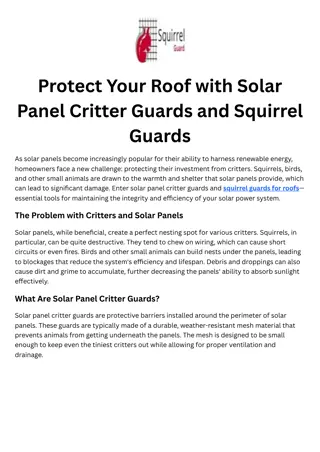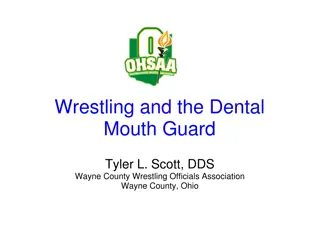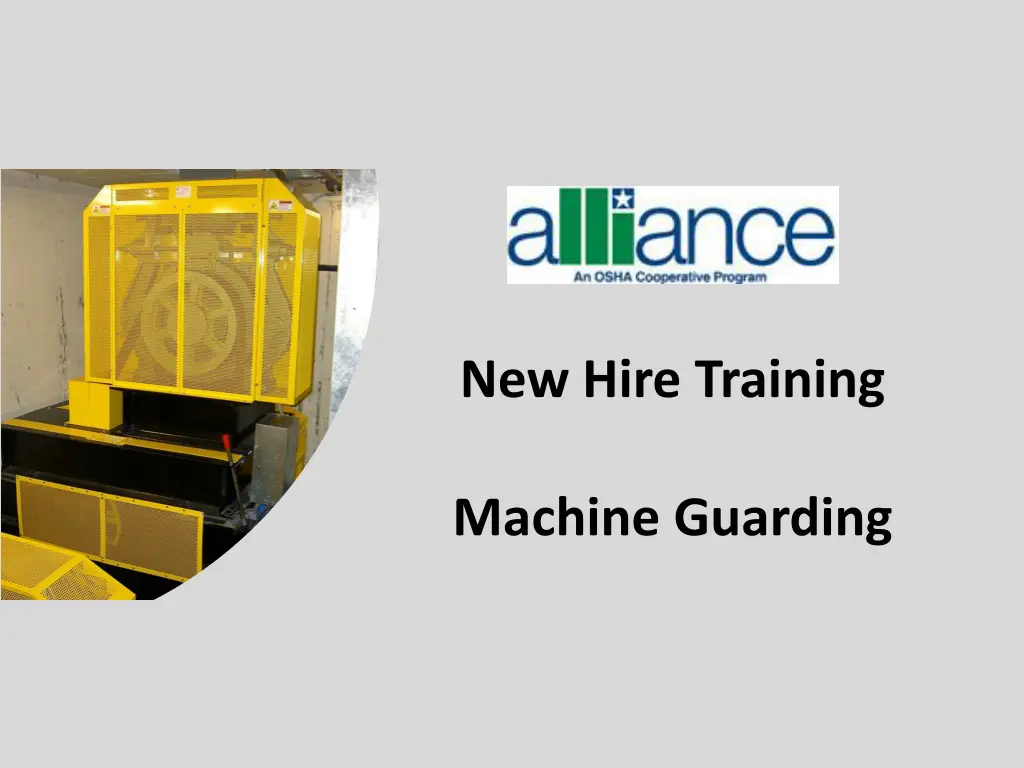
Machine Guarding Training: Preventing Accidents and Ensuring Safety
Learn about the importance of machine guarding in preventing workplace accidents and protecting employees from injuries such as crushed fingers, burns, and more. This training covers essential topics like elevator machinery hazards, rotating parts safety, nip points, and guard requirements to maintain a safe work environment.
Download Presentation

Please find below an Image/Link to download the presentation.
The content on the website is provided AS IS for your information and personal use only. It may not be sold, licensed, or shared on other websites without obtaining consent from the author. If you encounter any issues during the download, it is possible that the publisher has removed the file from their server.
You are allowed to download the files provided on this website for personal or commercial use, subject to the condition that they are used lawfully. All files are the property of their respective owners.
The content on the website is provided AS IS for your information and personal use only. It may not be sold, licensed, or shared on other websites without obtaining consent from the author.
E N D
Presentation Transcript
New Hire Training Machine Guarding
Machine Guarding Introduction Introduction Many accidents result from persons working on, or around, moving machinery. These accidents could have been prevented by the installation and proper maintenance of guarding. The goal of this training is to make the guarding of all equipment as easily understood as possible and re-enforce the safe working procedures that must always be in place around dangerous equipment. Possible machinery-related injuries include: Crushed fingers or hands Amputations Burns Blindness A good rule to remember is: Any machine part, function, or process which may cause injury must be safeguarded.
Machine Guarding Machinery Accidents Machinery Accidents Examples of how elevator machinery and other conveyances accidents can occur include: Reaching in to moving/running equipment Not using lockout/tagout procedures Unauthorized or untrained persons doing maintenance or using the machines Missing or loose machine guards
Machine Guarding Basic Elevator and Conveyance Machinery Parts and Basic Elevator and Conveyance Machinery Parts and Hazards Hazards Rotating parts with hazardous projections Rotating motion can be dangerous; even smooth, slowly rotating shafts can grip hair and clothing. Injuries due to contact with rotating parts can be severe. Pump units and brake couplings, sheaves and machines are just a few of the rotating hazards that elevator constructors need to be aware of.
Machine Guarding Basic Elevator Machinery and Conveyances Basic Elevator Machinery and Conveyances Parts and Hazards Parts and Hazards Common nip points on rotating parts In-running nip point hazards are caused by the rotating parts on machinery. As seen here, this danger is common on machines with intermeshing gears,
Machine Guarding Basic Elevator and Conveyance Basic Elevator and Conveyance Machinery Parts and Hazards Machinery Parts and Hazards Nip points between rotating machine components Nip points can occur between rotating and fixed parts which create a shearing, crushing, or abrading action.
Machine Guarding Requirements for guards Requirements for guards Guards must meet these minimum general requirements: Prevent contact: The guard must prevent hands, arms, and any other part of a worker's body from making contact with dangerous moving parts. Be secured: Workers should not be able to easily remove or tamper with the guard Protect from falling objects: The guard should ensure that no objects can fall into moving parts. Create no new hazards: A guard defeats its own purpose if it creates a hazard of its own such as a shear point, a jagged edge, or an unfinished surface which can cause a laceration. Create no interference: Any guard which impedes a worker from performing the job quickly and comfortably might soon be overridden or disregarded. Allow safe lubrication: If possible, one should be able to lubricate the machine without removing the guards.
Machine Guarding Guards on tools Never use a tool without the guard installed and properly adjusted. This grinder is shown with an additional guard to accommodate a larger grinding wheel.
Machine Guarding Summary Summary Guards are essential for protecting workers from needless and preventable machinery-related injuries All parts of the machine that move while the machine is working, must be guarded A good rule to remember is: Any machine part, function, or process which may cause injury must be guarded
Through the Alliance between OSHAs 10 Regional Offices and the Elevator Contractors of America (ECA), Elevator Industry Work Preservation Fund (EIWPF), International Union of Elevator Constructors (IUEC), National Association of Elevator Contractors (NAEC), National Elevator Industry Educational Program (NEIEP), and National Elevator Industry Inc. (NEII), collectively known as The Elevator Industry Safety Partners, developed this Industry Specific Training for informational purposes only. It does not necessarily reflect the official views of OSHA or the U.S. Department of Labor. March 2025 Under the Occupational Safety and Health Act, employers are responsible (http://www.osha.gov/as/opa/worker/employer-responsibility.html) for providing a safe and healthy workplace and workers have rights (https://www.osha.gov/workers). OSHA can help answer questions or concerns from employers and workers. OSHA's On-Site Consultation Program (https://www.osha.gov/consultation) offers free and confidential advice to small and medium-sized businesses, with priority given to high-hazard worksites. For more information, contact your regional or area OSHA office (https://www.osha.gov/contactus/bystate), call 1-800- 321-OSHA (6742), or visit https://www.osha.gov/.


